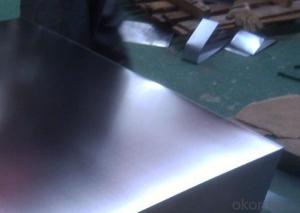JIS G3303 Electrolytic Tin Plate
- Loading Port:
- China Main Port
- Payment Terms:
- TT OR LC
- Min Order Qty:
- -
- Supply Capability:
- -
OKorder Service Pledge
Quality Product, Order Online Tracking, Timely Delivery
OKorder Financial Service
Credit Rating, Credit Services, Credit Purchasing
You Might Also Like
Quick Details
Standard:AISI, ASTM, BS, DIN, GB, JIS
Grade:MR,SPCC,SPCD,08AL,Q195L
Thickness:0.10-1.0mm
Model Number:tinplate coil/sheet
Type:Steel Plate
Technique:Hot Rolled
Surface Treatment:Silver, Matt
Application:Food cans, industrial cans and paint cans
Special Use:High-strength Steel Plate
Width:300~1000mm
Length:as per your request
surface:bright,stone,matt
- Q:Can tinplate be used for vacuum-sealed packaging?
- Yes, tinplate can be used for vacuum-sealed packaging. Tinplate is known for its excellent barrier properties against moisture, air, and light, making it a suitable material for sealing food and other perishable items in a vacuum-sealed environment.
- Q:How does tinplate packaging contribute to brand recognition?
- Tinplate packaging contributes to brand recognition by offering a distinctive and visually appealing presentation of the product. The use of tinplate materials allows for unique designs, vibrant colors, and intricate details that can catch the attention of consumers. This eye-catching packaging helps to create a lasting impression on customers, making them more likely to remember and recognize the brand. Additionally, the durability and premium feel of tinplate packaging can enhance the perceived value and quality of the product, further strengthening brand recognition and loyalty.
- Q:Can tinplate be used in extreme temperatures?
- Yes, tinplate can be used in extreme temperatures. It is known for its excellent resistance to high and low temperatures, making it suitable for various applications in extreme environments.
- Q:How does tinplate affect the recyclability of mixed-material packaging?
- Tinplate plays a significant role in enhancing the recyclability of mixed-material packaging. It is highly recyclable and has a well-established recycling infrastructure worldwide. By incorporating tinplate into mixed-material packaging, it enables easier separation of different materials during the recycling process. Tinplate's recyclability helps reduce waste and conserve resources by enabling the recovery and reuse of valuable materials, ultimately promoting a more sustainable packaging system.
- Q:Can tinplate be used for coffee or tea packaging?
- Yes, tinplate can be used for coffee or tea packaging. Tinplate is a popular choice for packaging due to its durability, resistance to moisture and oxygen, and ability to preserve the aroma and flavor of coffee or tea.
- Q:How does tinplate affect the overall product freshness?
- Tinplate, due to its excellent barrier properties, helps to preserve the freshness and quality of products. It prevents oxygen and moisture from entering the packaging, thereby reducing the risk of spoilage, deterioration, or contamination. This ensures that the product remains fresh and maintains its desired characteristics for an extended period.
- Q:How does tinplate contribute to the attractiveness of cosmetic packaging?
- Tinplate contributes to the attractiveness of cosmetic packaging by providing a sleek and shiny appearance. It adds a touch of elegance and sophistication to the packaging, making it visually appealing and enticing to consumers. The use of tinplate also allows for creative and intricate designs to be printed on the packaging, enhancing its overall aesthetic appeal. Additionally, tinplate's durability and resistance to corrosion ensure that the packaging remains in pristine condition, further enhancing the attractiveness of cosmetic products.
- Q:How is tinplate coated for paint cans?
- Tinplate is coated for paint cans using a process called electrolytic tin coating. This involves immersing the tinplate in an electrolyte solution and passing an electric current through it. The current causes tin ions to be deposited onto the surface of the tinplate, creating a thin layer of tin coating. This tin coating provides the necessary corrosion resistance and ensures the paint cans remain durable and long-lasting.
- Q:What are the main challenges in recycling tinplate?
- The main challenges in recycling tinplate include the separation of tin from the steel base, the removal of any contaminants or coatings on the tinplate, and ensuring the proper sorting and collection of tinplate waste to prevent it from ending up in landfills. Additionally, the energy-intensive process of melting and refining tinplate poses environmental concerns and requires adequate infrastructure for recycling facilities.
- Q:Is tinplate safe for contact with skin?
- Yes, tinplate is generally safe for contact with the skin. Tin is non-toxic and does not react with skin or cause any known skin allergies or irritations. However, if the tinplate has sharp or rough edges, it may cause minor cuts or abrasions. It is always important to ensure that tinplate objects are free from any sharp edges or rough surfaces before using them in direct contact with the skin.
1. Manufacturer Overview |
|
|---|---|
| Location | |
| Year Established | |
| Annual Output Value | |
| Main Markets | |
| Company Certifications | |
2. Manufacturer Certificates |
|
|---|---|
| a) Certification Name | |
| Range | |
| Reference | |
| Validity Period | |
3. Manufacturer Capability |
|
|---|---|
| a)Trade Capacity | |
| Nearest Port | |
| Export Percentage | |
| No.of Employees in Trade Department | |
| Language Spoken: | |
| b)Factory Information | |
| Factory Size: | |
| No. of Production Lines | |
| Contract Manufacturing | |
| Product Price Range | |
Send your message to us
JIS G3303 Electrolytic Tin Plate
- Loading Port:
- China Main Port
- Payment Terms:
- TT OR LC
- Min Order Qty:
- -
- Supply Capability:
- -
OKorder Service Pledge
Quality Product, Order Online Tracking, Timely Delivery
OKorder Financial Service
Credit Rating, Credit Services, Credit Purchasing
Similar products
New products
Hot products
Related keywords

























